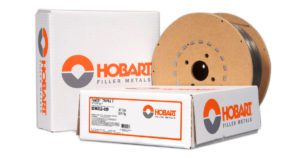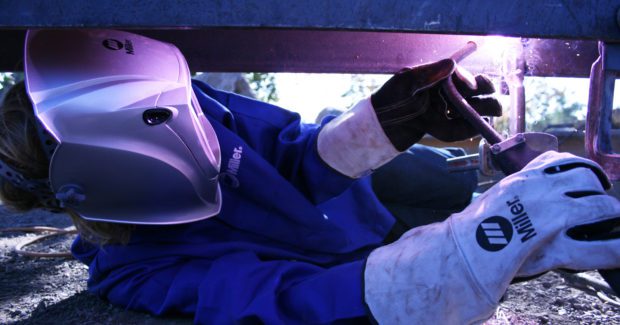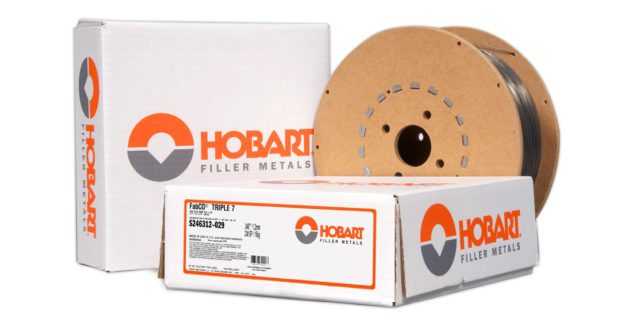Gas- and Self-Shielded Carbon Steel Flux-Cored Wires and Their Weldability
Ensure you are operating within the correct parameters to gain the best results when using these wires.
Posted: June 24, 2022

WELDING TIPS
While gas- and self-shielded flux-cored wires have applications that they are best suited for, they provide many of the same advantages. Both offer high deposition rates — the amount of weld metal placed in the weld joint during a specific period — and deposition efficiency — the ratio of the weight of metal deposited to the amount of filler metal used expressed as a percentage. They are also more tolerant of welding over contaminants compared to other filler metals, such as solid wire.
Both types of flux-cored wires can weld a variety of carbon steels and other ferrous materials and a range of thicknesses. And while each classification has varying degrees of weldability based on arc stability, spatter levels, slag removal and overall welding bead appearance, they generally appeal well to operators.
The American Welding Society (AWS) A5.20/A5.20M:2021 Specification for Carbon Steel Electrodes for Flux-Cored Arc Welding sets the standard that wires must meet to bear a specific classification. Within each classification, the wires have distinct characteristics that impact their weldability, and they feature designators that indicate their composition and intended use. These designators begin with a T followed by a dash and a number. For example, AWS E71T-1.
A Look at Gas-shielded Flux-cored Wires
Gas-shielded flux-cored wires can be used in applications ranging from general fabrication and construction to shipbuilding and more. They require an external shielding gas, usually either 100% CO2 or a 75-to-80% argon/CO2 balance. The shielding gas being used can influence weldability, including welding spatter levels and arc stability.
There are several commonly used gas-shielded flux-cored wires.
T-1, T-9 and T-12 wires feature similar welding characteristics, have good operator appeal, such as a stable arc, and are considered easy to use. All three use DCEP polarity, are single- and multiple-pass capable and feature a rutile-based slag system. Smaller wires (1/16 inch or less) can be used for all-position welding, whereas larger wires (5/64 inch or more) are normally usable in the flat and horizontal positions only. The wires generally produce low welding spatter levels and moderate but full coverage slag with good release, along with a flat to slightly convex weld bead appearance. Some of the wires with these classifications have both 100% CO2 (C) and 75-to-80% argon/CO2 balance (M) designators for greater versatility in applications that they can be used for. More argon in a mixture helps improve arc smoothness and out-of-position welding capabilities based on manufacturer’s recommendations.
T-1 wires have mechanical requirements from AWS of 70-to-95 ksi tensile strength (for mild steel products), 58 ksi minimum yield strength, 22% minimum elongation and a minimum impact toughness of 20 ft-lbs at 0°F Charpy V-Notch (CVN).
T-9 wires have the same mechanical requirements but provide greater impact toughness: 20 ft– lbs at -20°F CVN.
T-12 wires are designed to meet the requirements of the ASME BPV (American Society of Mechanical Engineer’s Boiler and Pressure Vessel) code, Section IX. Specifically, they have lower manganese, which reduces tensile strength and hardness, along with cracking risks; and they have a tighter chemistry and tensile tolerance requirement of 70-to-90 ksi.
Unlike T-1, T-9 and T-12 wires, T-5 wires have a basic slag that makes them less welder-friendly to use. However, the upside of these wires is their exceptional mechanical properties that help mitigate hot and cold cracking. The wires offer a driving arc, which increases penetration on thicker materials.
What to Know About Self-shielded Flux-cored Wires
Self-shielded flux-cored wires are often a substitute for stick electrodes for construction and other outdoor applications. They don’t require an external shielding gas, and they weld faster than stick electrodes since the wires continually feed, allowing for greater productivity.
Some common self-shielded flux-cored wires include T-6, T-8 and T-11. The latter two wires offer faster-freezing slag for improved out-of-position welding capabilities. T-6 wires provide slower-freezing slag.
T-6 wires offer impact toughness of a minimum of 20 ft-lbs. at -20°F to help resist cracking in applications exposed to harsh environments. These include bridge and structural construction. Their arc drives well into the joint, resulting in consistent root penetration, and the slag is easy to remove. T-6 wires are used for flat and horizontal welding applications.
T-8 wires offer the same impact toughness as T-6 and can be used for all-position welding on materials with no thickness restrictions. Some filler metal manufacturers offer T-8 wires with a J designator, which means the wires offer impact toughness to -40°F. T-8 wires are commonly used in applications that must meet the requirements of the AWS D1.8/D1.8M Structural Welding Code – Seismic Supplement for Demand Critical Welds so that they can be used in areas prone to seismic activity. They require careful attention to technique by the welding operator, as they are less forgiving to errors than a T-11 wire and can be more difficult to use.
Unlike T-6 and T-8 wires, T-11 wires do not require impact toughness testing and they are not as crack resistant. They are general-purpose wire for outdoor applications and are versatile and easy to weld with. Even though they cannot be used for critical welding, AWS D1.1 Structural Welding Code for Steel deems them usable on materials less than ½-inch thick.
Final Considerations
Whether welding with gas- or self-shielded flux-cored wires, gaining the best results depends on operating within the correct parameters. Always consult the wire’s data sheet for details. These are available on most filler metal manufacturers’ websites. There, welding operators can find recommended polarity, voltage, amperage and wire-speed settings, along with shielding gas requirements (when necessary), wire stickout details and more. Following these recommendations not only reduces the risk of problems that require downtime for troubleshooting, but it also helps ensure the wires operate as they were intended.
Subscribe to learn the latest in manufacturing.






